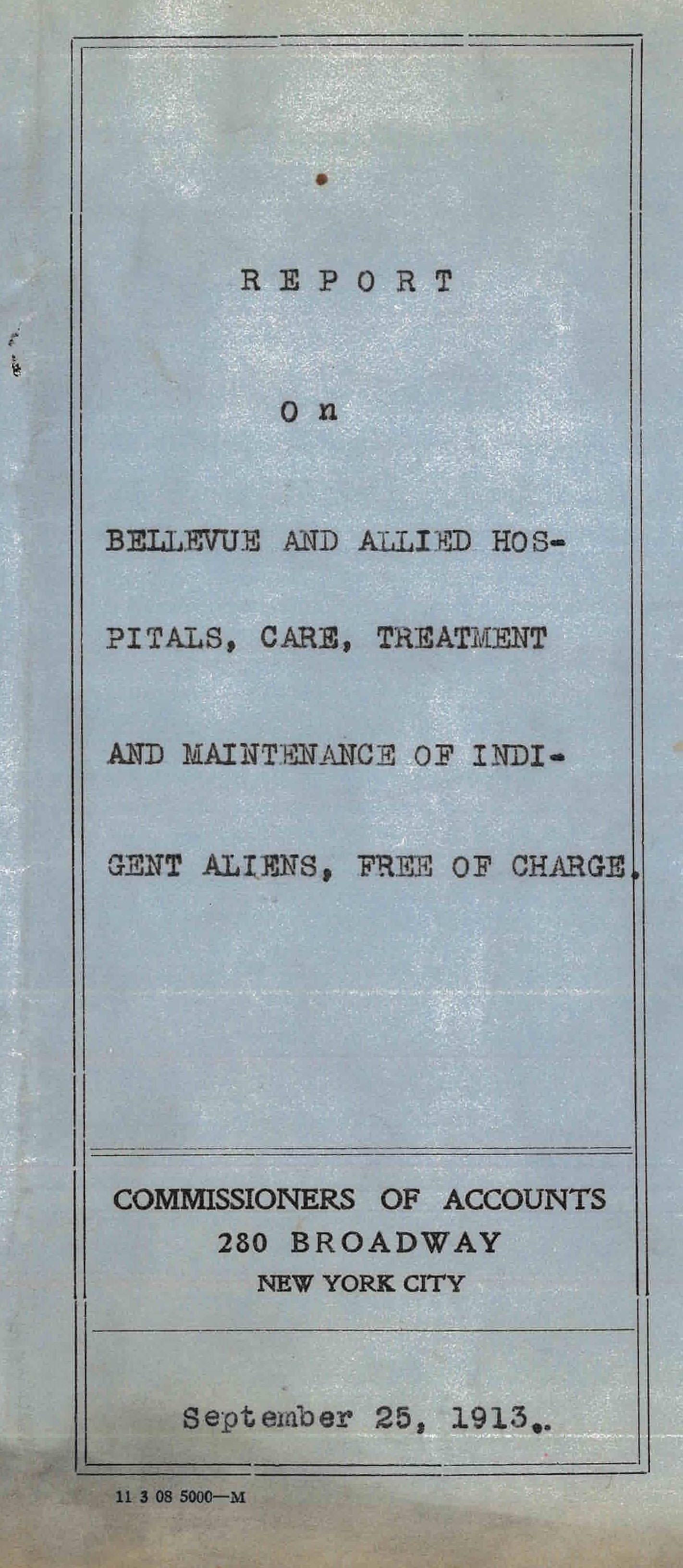A recent search for reports about immigration in the Municipal Library, showed that the earliest report in the collection was issued by the Office of the Commissioner of Accounts in 1913. Sent to the Honorable Ardolph L. Kline, Mayor, the subject was the treatment of indigent aliens, free of charge, at Bellevue and Allied Hospitals.
Report on Bellevue and Allied Hospitals, Care, Treatment and Maintenance of Indigent Aliens, Free of Charge, 1913. Office of the Mayor (Kline) Collection, NYC Municipal Archives.
The Office of the Commissioner of Accounts (Accounts) was created in 1873 to investigate the City’s operations and financial controls after the Boss Tweed scandals. It evolved into the Department of Investigation and Accounts and today exists as the Department of Investigation. Reviewing files in the Office of the Mayor collections in the Municipal Archives, it would appear that the Commissioners of Accounts covered a lot of territory. In 1913, report topics ranged from the administration of the many courts within the City of New York, to an examination of Police Pension Fund accounts, to an investigation at the request of Mayor William Gaynor and Fire Commissioner Joseph Johnson into firefighters involvement in passing “two platoon” legislation and more.
One document in Mayor Kline’s Departmental Correspondence Received series resonates today: the aforementioned memo regarding the cost of hospital care.
According to the National Archives, more than 20 million immigrants arrived at Ellis Island between 1892 and 1924. Not all stayed in New York City, but many did. Seventy-five percent of New York City residents were immigrants or born to immigrants, the Library of Congress reports. New York was known, then and now, for the diversity of its population. Immigration and industrialization went hand-in-hand and New York’s immigrant residents made the City a manufacturing hub. The new arrivals also faced discrimination and endured harsh living conditions. Federal regulations permitted the deportation of immigrants who might become a public charge.
Report on Bellevue and Allied Hospitals, Care, Treatment and Maintenance of Indigent Aliens, Free of Charge, 1913. Office of the Mayor (Kline) Collection, NYC Municipal Archives.
In 1913, there were three public hospital systems in the City. One operated by the Department of Public Charities oversaw operations at ten hospitals. The Health Department had oversight of six hospitals. The third, the Bellevue and Allied Hospitals, consisted of five institutions: Bellevue Hospital, Harlem Hospital, Gouverneur Hospital, Fordham Hospital and Emergency Hospital. A lengthy December 26, 1913 report from Accounts described this system as “archaic and ineconomical,”(sic) leading to “conflict of authority.” It reported horrific patient treatment, unsanitary conditions, and lax practices. The final sentence in the report comes under the heading Free Treatment of Aliens. “A report (file NO1852) upon the free treatment of aliens, and its very large cost to the city was submitted to the mayor under date of September 25, 1913.”
The Accounts report stated that 57,422 persons were treated at the Bellevue and Allied hospitals. A sampling of the 11,224 records of cases treated in a three-month period showed that “671 were less than three years in this country, and consequently were not citizens.” In the margin of the report is a handwritten calculation in pencil showing that the percent of noncitizens was 6% of those treated. We expect this was calculated by Mayor Kline. Further down, the Accounts report stated that using the percent derived from their sampling, “approximately 9,879 aliens, not citizens of this country, were treated without charge.” The average cost of treatment of each patient during these three years was $21.10, and on this basis the total cost of the aliens treated during the three years therefore amounted to $208,446.90. An inflation calculator shows this would be $6,464,510. in 2023 dollars.
Report, page 2. Office of the Mayor (Kline) Collection, NYC Municipal Archives.
Report, page 3. Office of the Mayor (Kline) Collection, NYC Municipal Archives.
The author took pains to note that the calculations were for people residing in the U.S. for less than three years and stated, “The inclusion of aliens of more than three years’ residence, who have been treated free of charge in these institutions, would considerably augment this sum... The imposition of this burden upon the municipal government it is contended is an injustice.” The report cites the then-existing federal law which provided that the Commissioner-General of Immigration was responsible for “the support and relief of such aliens as may fall into distress or need public aid.”
The report criticized the low reimbursement rates paid by the federal government and the process by which the payments were calculated. Payments were made only for cases in which deportation warrants were issued, which occurred after the individual was housed in the city hospitals while Immigration doctors determined whether they should be deported so they wouldn’t become a public charge, which triggered deportation.
Report, page 4. Office of the Mayor (Kline) Collection, NYC Municipal Archives.
“The city is not reimbursed for expenses incurred for the care and treatment of these patients at the hospitals during the investigation, which often consumes several weeks before the issue of the warrant. If the investigation fails to develop facts sufficient to warrant deportation the city receives nothing for care and treatment during the period of detention.” Between 1902 and December 1913, the City was reimbursed only $1,149—far less than the Commissioners of Accounts calculated was fairly due.
The report recommended that the Trustees of the Bellevue and Allied Hospitals begin negotiations with federal authority “with a view to relieving the City of New York of the unjust share of this federal burden which it bears at the present time…”
It’s not clear that City officials acted on this recommendation. There are no letters in the Mayor Kline collection to the federal government requesting full reimbursement. It is clear, though, that the City took on the responsibility of caring for immigrants in poor health, even if not fully compensated.
